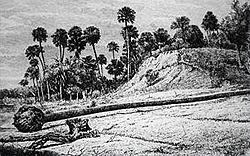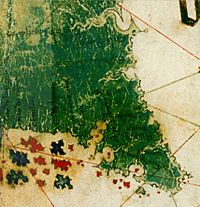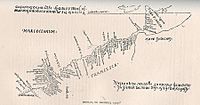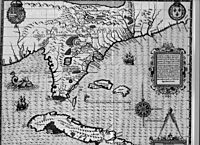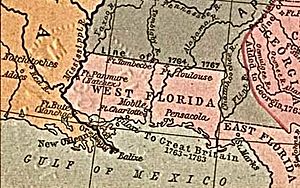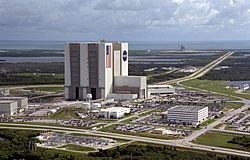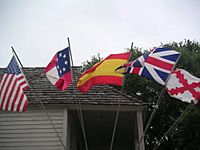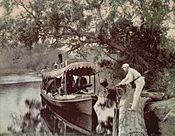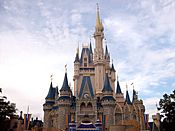History of Florida facts for kids
Quick facts for kids History of Florida |
|
|---|---|
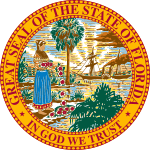
The seal of Florida reflects the state's Native American ancestry
|
|
| Historical Periods | |
| Pre-history | until 1497 |
| Spanish Rule | 1513–1763 |
| British Rule | 1763–1783 |
| Spanish Rule | 1783–1821 |
| U.S. Territorial Period | 1822–1845 |
| Statehood | 1845–present |
| Major Events | |
| American Revolutionary War | 1775–1783 |
| War of 1812 | 1811–1814 |
| First Seminole War | 1817–1818 |
| Capitol moved to Tallahassee |
1824 |
| Second Seminole War | 1835–1842 |
| Constitutional convention | 1838 |
| Third Seminole War | 1855–1858 |
| Ordinance of Secession | 1861 |
| Civil War | 1861–1865 |
| 3rd Constitution | 1865 |
| Reconstruction | 1865–1868 |
| 4th Constitution | 1868 |
| 5th Constitution | 1885 |
| Great Migration | 1910–1930 |
| Land Boom | 1925–1929 |
| 6th Constitution | 1968 |
| Gore v. Harris 2000 Presidential Election |
2000 |
| Timeline | |
The history of Florida can be traced to when the first Native Americans began to inhabit the peninsula as early as 14,000 years ago. They left behind artifacts and archeological evidence. Florida's written history begins with the arrival of Europeans; the Spanish explorer Juan Ponce de León in 1513 made the first textual records. The state received its name from that conquistador, who called the peninsula La Pascua Florida in recognition of the verdant landscape and because it was the Easter season, which the Spaniards called Pascua Florida (Festival of Flowers).
This area was the first mainland realm of the United States to be settled by Europeans. Thus, 1513 marked the beginning of the American frontier. From that time of contact, Florida has had many waves of colonization and immigration, including French and Spanish settlement during the 16th century, as well as entry of new Native American groups migrating from elsewhere in the South, and free blacks and fugitive slaves, who in the 19th century became allied with the Native Americans as Black Seminoles. Florida was under colonial rule by Spain from the 16th century to the 19th century, and briefly by Great Britain during the 18th century (1763–1783) before becoming a territory of the United States in 1821. Two decades later, on March 3, 1845, Florida was admitted to the Union as the 27th U.S. state.
Florida is nicknamed the "Sunshine State" due to its warm climate and days of sunshine. Florida's sunny climate, many beaches, and growth of industries have attracted northern migrants within the United States, international migrants, and vacationers since the Florida land boom of the 1920s. A diverse population, urbanization, and a diverse economy would develop in Florida throughout the 20th century. In 2014, Florida with over 19 million people, surpassed New York and became the third most populous state in the U.S.
The economy of Florida has changed over its history, starting with natural resource exploitation in logging, mining, fishing, and sponge diving; as well as cattle ranching, farming, and citrus growing. The tourism, real estate, trade, banking, and retirement destination businesses would develop as economic sectors later on.
Contents
Early history
Geologic
The foundation of Florida was located in the continent of Gondwana at the South Pole 650 Mya. When Gondwana collided with the continent of Laurentia 300 Mya, it had moved further north. 200 Mya, the merged continents containing what would be Florida, had moved north of the equator. By then, Florida was surrounded by desert, in the middle of a new continent, Pangaea. When Pangaea broke up 115 mya, Florida assumed a shape as a peninsula. The emergent landmass of Florida was Orange Island, a low-relief island sitting atop the carbonate Florida Platform which emerged about 34 to 28 million years ago.
When glaciation locked up the world's water, starting 2.58 million years ago, the sea level dropped precipitously. It was approximately 100 metres (330 ft) lower than present levels. As a result, the Florida peninsula not only emerged, but had a land area about twice what it is today. Florida also had a drier and cooler climate than in more recent times. There were few flowing rivers or wetlands.
First Floridians
Paleo-Indians entered what is now Florida at least 14,000 years ago. Across large areas of Florida, fresh water was available only in sinkholes and limestone catchment basins. As a result, most paleo-Indian activity was around the watering holes. Sinkholes and basins in the beds of modern rivers (such as the Page-Ladson prehistory site in the Aucilla River) have yielded a rich trove of paleo-Indian artifacts, including Clovis points.
Excavations at an ancient stone quarry (the Container Corporation of America site in Marion County) yielded "crude stone implements" showing signs of extensive wear from deposits below those holding Paleo-Indian artifacts. Thermoluminescence dating and weathering analysis independently gave dates of 26,000 to 28,000 years ago for the creation of the artifacts. The findings are controversial, and funding has not been available for follow-up studies.
As the glaciers began retreating about 8000 BC, the climate of Florida became warmer and wetter. As the glaciers melted, the sea level rose, reducing the land mass. Many prehistoric habitation sites along the old coastline were slowly submerged, making artifacts from early coastal cultures difficult to find. The paleo-Indian culture was replaced by, or evolved into, the Early Archaic culture. With an increase in population and more water available, the people occupied many more locations, as evidenced by numerous artifacts. Archaeologists have learned much about the Early Archaic people of Florida from the discoveries made at Windover Pond. The Early Archaic period evolved into the Middle Archaic period around 5000 BC. People started living in villages near wetlands and favored sites that were likely occupied for multiple generations.
The Late Archaic period started about 3000 BC, when Florida's climate had reached current conditions and the sea had risen close to its present level. People commonly occupied both fresh and saltwater wetlands. Large shell middens accumulated during this period. Many people lived in large villages with purpose-built earthwork mounds, such as at Horr's Island, which had the largest permanently occupied community in the Archaic period in the southeastern United States. It also has the oldest burial mound in the East, dating to about 1450 BC. People began making fired pottery in Florida by 2000 BC. By about 500 BC, the Archaic culture, which had been fairly uniform across Florida, began to fragment into regional cultures.
The post-Archaic cultures of eastern and southern Florida developed in relative isolation. It is likely that the peoples living in those areas at the time of first European contact were direct descendants of the inhabitants of the areas in late Archaic and Woodland times. The cultures of the Florida panhandle and the north and central Gulf coast of the Florida peninsula were strongly influenced by the Mississippian culture, producing two local variants known as the Pensacola culture and the Fort Walton culture.
Continuity in cultural history suggests that the peoples of those areas were also descended from the inhabitants of the Archaic period. In the panhandle and the northern part of the peninsula, people adopted cultivation of maize. Its cultivation was restricted or absent among the tribes who lived south of the Timucuan-speaking people (i.e., south of a line approximately from present-day Daytona Beach, Florida to a point on or north of Tampa Bay.) Peoples in southern Florida depended on the rich estuarine environment and developed a highly complex society without agriculture.
European contact and aftermath
At the time of first European contact in the early 16th century, Florida was inhabited by an estimated 350,000 people belonging to a number of tribes. The Spanish recorded nearly one hundred names of groups they encountered, ranging from organized political entities such as the Apalachee, with a population of around 50,000, to villages with no known political affiliation. There were an estimated 150,000 speakers of dialects of the Timucua language, but the Timucua were organized as groups of villages and did not share a common culture.
Other tribes in Florida at the time of first contact included the Ais, Calusa, Jaega, Mayaimi, Tequesta and Tocobaga. Early explorers such as Alvaro Mexia wrote about them; other information has been learned through archeological research. The populations of all of these tribes decreased markedly during the period of Spanish control of Florida, mostly due to epidemics of newly introduced infectious diseases, to which the Native Americans had no natural immunity. The diminished population of the original natives allowed outside groups, such as the Seminoles to move into the area starting about 1700.
At the beginning of the 18th century, when the indigenous peoples were already much reduced in populations, tribes from areas to the north of Florida, supplied with arms and occasionally accompanied by white colonists from the Province of Carolina, raided throughout Florida. They burned villages, wounded many of the inhabitants and carried captives back to Charles Towne to be sold into slavery. Most of the villages in Florida were abandoned, and the survivors sought refuge at St. Augustine or in isolated spots around the state. Many tribes became extinct during this period and by the end of the 18th century.
Some of the Apalachee eventually reached Louisiana, where they survived as a distinct group for at least another century. The Spanish evacuated the few surviving members of the Florida tribes to Cuba in 1763 when Spain transferred the territory of Florida to the British Empire following the latter's victory against France in the Seven Years' War. In the aftermath, the Seminole, originally an offshoot of the Creek people who absorbed other groups, developed as a distinct tribe in Florida during the 18th century through the process of ethnogenesis. They have three federally recognized tribes: the largest is the Seminole Nation of Oklahoma, formed of descendants since removal in the 1830s; others are the smaller Seminole Tribe of Florida and the Miccosukee Tribe of Indians of Florida.
Colonial battleground
First Spanish rule (1513–1763)
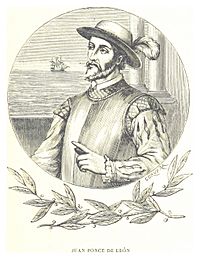
Juan Ponce de León, a famous Spanish conqueror and explorer, is usually given credit for being the first European to sight Florida, but he probably had predecessors. Florida and much of the nearby coast is depicted in the Cantino planisphere, an early world map which was surreptitiously copied in 1502 from the most current Portuguese sailing charts and smuggled into Italy a full decade before Ponce sailed north from Puerto Rico on his voyage of exploration. Ponce de León may not have even been the first Spaniard to go ashore in Florida; slave traders may have secretly raided native villages before Ponce arrived, as he encountered at least one indigenous tribesman who spoke Spanish. However, Ponce's 1513 expedition to Florida was the first open and official one. He also gave Florida its name, which means "full of flowers." Another dubious legend states that Ponce de León was searching for the Fountain of Youth on the island of Bimini, based on information from natives.
On March 3, 1513, Juan Ponce de León organized and equipped three ships for an expedition departing from "Punta Aguada," Puerto Rico. The expedition included 200 people, including women and free blacks.
Although it is often stated that he sighted the peninsula for the first time on March 27, 1513 and thought it was an island, he probably saw one of the Bahamas at that time. He went ashore on Florida's east coast during the Spanish Easter feast, Pascua Florida, on April 7 and named the land La Pascua de la Florida. After briefly exploring the land south of present-day St. Augustine, the expedition sailed south to the bottom of the Florida peninsula, through the Florida Keys, and up the west coast as far north as Charlotte Harbor, where they briefly skirmished with the Calusa before heading back to Puerto Rico. From 1513 onward, the land became known as La Florida. After 1630, and throughout the 18th century, Tegesta (after the Tequesta tribe) was an alternate name of choice for the Florida peninsula following publication of a map by the Dutch cartographer Hessel Gerritsz in Joannes de Laet's History of the New World.
Further Spanish attempts to explore and colonize Florida were disastrous. Ponce de León returned to the Charlotte Harbor area in 1521 with equipment and settlers to start a colony, but was soon driven off by hostile Calusa, and de León died in Cuba from wounds received in the fighting. Pánfilo de Narváez's expedition explored Florida's west coast in 1528, but his violent demands for gold and food led to hostile relations with the Tocobaga and other native groups. Facing starvation and unable to find his support ships, Narváez attempted return to Mexico via rafts, but all were lost at sea and only four members of the expedition survived. Hernando de Soto landed in Florida in 1539 and began a multi-year trek through what is now the southeastern United States in which he found no gold but lost his life. In 1559 Tristán de Luna y Arellano established the first settlement in Pensacola but, after a violent hurricane destroyed the area, it was abandoned in 1561.
The horse, which the natives had hunted to extinction 10,000 years ago, was reintroduced into North America by the European explorers, and into Florida in 1538. As the animals were lost or stolen, they began to become feral.
In 1564, René Goulaine de Laudonnière founded Fort Caroline in what is now Jacksonville, as a haven for Huguenot Protestant refugees from religious persecution in France. Further down the coast, in 1565 Pedro Menéndez de Avilés founded San Agustín (St. Augustine) which is the oldest continuously inhabited European settlement in any U.S. state. It is second oldest only to San Juan, Puerto Rico in the United States' current territory. From this base of operations, the Spanish began building Catholic missions.
All colonial cities were founded near the mouths of rivers. St. Augustine was founded where the Mantanzas Inlet permitted access to the Indian River Lagoon. Other cities were founded on the sea with similar inlets: Jacksonville, West Palm Beach, Fort Lauderdale, Miami, Pensacola, Tampa, Fort Myers, and others.
On September 20, 1565, Menéndez de Avilés attacked Fort Caroline, killing most of the French Huguenot defenders. Two years later, Dominique de Gourgue recaptured the settlement for France, this time slaughtering the Spanish defenders.
St. Augustine became the most important settlement in Florida. Little more than a fort, it was frequently attacked and burned, with most residents killed or fled. It was notably devastated in 1586, when English sea captain and sometime pirate Sir Francis Drake plundered and burned the city. Catholic missionaries used St. Augustine as a base of operations to establish over 100 far-flung missions throughout Florida. They converted 26,000 natives by 1655, but a revolt in 1656 and an epidemic in 1659 proved devastating. Pirate attacks and British raids were unrelenting, and the town was burned to the ground several times until Spain fortified it with the Castillo de San Marcos (1672) and Fort Matanzas (1742).
Throughout the 17th century, English settlers in Virginia and the Carolinas gradually pushed the boundaries of Spanish territory south, while the French settlements along the Mississippi River encroached on the western borders of the Spanish claim. In 1702, English colonel James Moore and allied Yamasee and Creek Indians attacked and razed the town of St. Augustine, but they could not gain control of the fort. In 1704, Moore and his soldiers began burning Spanish missions in north Florida and executing Indians friendly with the Spanish. The collapse of the Spanish mission system and the defeat of the Spanish-allied Apalachee Indians (the Apalachee massacre) opened Florida up to slave raids, which reached to the Florida Keys and decimated the native population. The Yamasee War of 1715–1717 in the Carolinas resulted in numerous Indian refugees, such as the Yamasee, moving south to Florida. In 1719, the French captured the Spanish settlement at Pensacola.
The British and their colonies made war repeatedly against the Spanish, especially in 1702 and again in 1740, when a large force under James Oglethorpe sailed south from Georgia and besieged St. Augustine but were unable to take the Castillo de San Marcos. The British colonists were angry that Spanish Florida was attracting a large number of Africans and African Americans in North America who sought freedom from British slavery. Spain offered the slaves freedom in Florida if they converted to Catholicism. They settled in a buffer community north of St. Augustine, called Gracia Real de Santa Teresa de Mose, the first settlement made of free blacks in North America.
Creek and Seminole Native Americans who had established buffer settlements in Florida at the invitation of the Spanish government also welcomed many of those slaves. In 1771, Governor John Moultrie wrote to the English Board of Trade that "It has been a practice for a good while past, for negroes to run away from their Masters, and get into the Indian towns, from whence it proved very difficult to get them back." When British government officials pressed the Seminole to return runaway slaves, they replied that they had "merely given hungry people food, and invited the slaveholders to catch the runaways themselves."
British rule (1763–1783)
In 1763, Spain traded Florida to the Kingdom of Great Britain for control of Havana, Cuba, which had been captured by the British during the Seven Years' War. It was part of a large expansion of British territory following the country's victory in the Seven Years' War. Almost the entire Spanish population left, taking along most of the remaining indigenous population to Cuba. The British divided the territory into East Florida and West Florida. The British soon constructed the King's Road connecting St. Augustine to Georgia. The road crossed the St. Johns River at a narrow point, which the Seminole called Wacca Pilatka and the British named "Cow Ford", both names ostensibly reflecting the fact that cattle were brought across the river there. The British government gave land grants to officers and soldiers who had fought in the French and Indian War in order to encourage settlement. In order to induce settlers to move to the two new colonies reports of the natural wealth of Florida were published in England. A large number of British colonists who were "energetic and of good character" moved to Florida, mostly coming from South Carolina, Georgia and England though there was also a group of settlers who came from the colony of Bermuda. This would be the first permanent English-speaking population in what is now Duval County, Baker County, St. Johns County and Nassau County. The British built good public roads and introduced the cultivation of sugar cane, indigo and fruits as well the export of lumber. As a result of these initiatives northeastern Florida prospered economically in a way it never did under Spanish rule. Furthermore, the British governors were directed to call general assemblies as soon as possible in order to make laws for the Floridas and in the meantime they were, with the advice of councils, to establish courts. This would be the first introduction of much of the English-derived legal system which Florida still has today including trial-by-jury, habeas corpus and county-based government.
A Scottish settler named Dr Andrew Turnbull transplanted around 1,500 indentured settlers, from Minorca, Majorca, Ibiza, Smyrna, Crete, Mani Peninsula, and Sicily, to grow hemp, sugarcane, indigo, and to produce rum. Settled at New Smyrna, within months the colony suffered major losses primarily due to insect-borne diseases and Native American raids. Most crops did not do well in the sandy Florida soil. Those that survived rarely equaled the quality produced in other colonies. The colonists tired of their servitude and Turnbull's rule. On several occasions, he used African slaves to whip his unruly settlers. The settlement collapsed and the survivors fled to safety with the British authorities in St. Augustine. Their descendants survive to this day, as does the name New Smyrna.
In 1767, the British moved the northern boundary of West Florida to a line extending from the mouth of the Yazoo River east to the Chattahoochee River (32° 28′north latitude), consisting of approximately the lower third of the present states of Mississippi and Alabama. During this time, Creek Indians migrated into Florida and formed the Seminole tribe.
When the Colonies declared independence, many Floridians condemned it. They had been almost unaffected (because East and West Florida were backwoods areas) by the Stamp Act Crisis of 1765, which led the 13 colonies to perceive a common interest threatened by Britain. Florida declined to send delegates to the Continental Congress. The majority of Floridians were Loyalists, grateful to the Crown, that remained loyal to Britain. Many actually helped lead raids on the American South. One disastrous attempt on the part of the American Forces to invade East Florida occurred at the Battle of Thomas Creek in Nassau County. It was led on May 17, 1777. American Colonel John Baker surrendered to the British. Another attempt, the Battle of Alligator Bridge took place on June 30, 1778.
The two Floridas remained loyal to Great Britain throughout the American Revolutionary War. However, Spain (participating indirectly in the war as an ally of France) captured Pensacola from the British in 1781. In 1783, the Treaty of Paris ended the Revolutionary War and returned all of Florida to Spanish control, but without specifying the boundaries. The Spanish wanted the expanded boundary, while the new United States demanded the old boundary at the 31st parallel north. In the Treaty of San Lorenzo of 1795, Spain recognized the 31st parallel as the boundary.
Second Spanish rule (1783–1821)
Spanish presence included a few officials and soldiers, but no new settlers. Most British residents left. The unguarded region became a haven for escaped slaves and a base for Indian attacks against the U.S., and the U.S. demanded Spain reform.
Americans of English descent and Scots-Irish descent began moving into northern Florida from the backwoods of Georgia and South Carolina. Though technically not allowed by the Spanish authorities, the Spanish were never able to effectively police the border region and the backwoods settlers from the United States would continue to migrate into Florida unchecked. These migrants, mixing with the already present British settlers who had remained in Florida since the British period, would be the progenitors of the population known as Florida Crackers.
These American settlers established a permanent foothold in the area and ignored Spanish officials. The British settlers who had remained also resented Spanish rule, leading to a rebellion in 1810 and the establishment for ninety days of the so-called Free and Independent Republic of West Florida on September 23. After meetings beginning in June, rebels overcame the Spanish garrison at Baton Rouge (now in Louisiana), and unfurled the flag of the new republic: a single white star on a blue field. This flag would later become known as the "Bonnie Blue Flag".
In 1810, parts of West Florida were annexed by proclamation of President James Madison, who claimed the region as part of the Louisiana Purchase. These parts were incorporated into the newly formed Territory of Orleans. The U.S. annexed the Mobile District of West Florida to the Mississippi Territory in 1812. Spain continued to dispute the area, though the United States gradually increased the area it occupied.
Seminole Indians based in East Florida began raiding Georgia settlements, and offering havens for runaway slaves. The United States Army led increasingly frequent incursions into Spanish territory, including the 1817–1818 campaign against the Seminole Indians by Andrew Jackson that became known as the First Seminole War. The United States now effectively controlled East Florida. Control was necessary according to Secretary of State John Quincy Adams because Florida had become "a derelict open to the occupancy of every enemy, civilized or savage, of the United States, and serving no other earthly purpose than as a post of annoyance to them." Florida had become a burden to Spain, which could not afford to send settlers or garrisons. Madrid therefore decided to cede the territory to the United States through the Adams-Onís Treaty, which took effect in 1821.
American Frontier
Florida Territory (1822–1845)
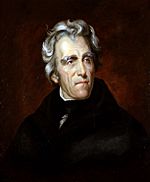
Florida became an organized territory of the United States on March 30, 1822. The Americans merged East Florida and West Florida (although the majority of West Florida was annexed to Territory of Orleans and Mississippi Territory), and established a new capital in Tallahassee, conveniently located halfway between the East Florida capital of St. Augustine and the West Florida capital of Pensacola. The boundaries of Florida's first two counties, Escambia and St. Johns, approximately coincided with the boundaries of West and East Florida respectively.
The free blacks and Indian slaves, Black Seminoles, living near St. Augustine, fled to Havana, Cuba to avoid coming under US control. Some Seminole also abandoned their settlements and moved further south. Hundreds of Black Seminoles and fugitive slaves escaped in the early nineteenth century from Cape Florida to The Bahamas, where they settled on Andros Island.
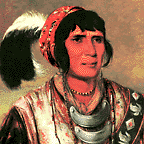
As settlement increased, pressure grew on the United States government to remove the Indians from their lands in Florida. Many settlers in Florida developed plantation agriculture, similar to other areas of the Deep South. To the consternation of new landowners, the Seminoles harbored and integrated runaway blacks, and clashes between whites and Indians grew with the influx of new settlers.
In 1832, the United States government signed the Treaty of Payne's Landing with some of the Seminole chiefs, promising them lands west of the Mississippi River if they agreed to leave Florida voluntarily. Many Seminoles left then, while those who remained prepared to defend their claims to the land. White settlers pressured the government to remove all of the Indians, by force if necessary, and in 1835, the U.S. Army arrived to enforce the treaty.
The Second Seminole War began at the end of 1835 with the Dade Massacre, when Seminoles ambushed Army troops marching from Fort Brooke (Tampa) to reinforce Fort King (Ocala). They killed or mortally wounded all but one of the 110 troops. Between 900 and 1,500 Seminole warriors effectively employed guerrilla tactics against United States Army troops for seven years. Osceola, a charismatic young war leader, came to symbolize the war and the Seminoles after he was arrested by Brigadier General Joseph Marion Hernandez while negotiating under a white truce flag in October 1837, by order of General Thomas Jesup. First imprisoned at Fort Marion, he died of malaria at Fort Moultrie in South Carolina less than three months after his capture. The war ended in 1842. The U.S. government is estimated to have spent between $20 million ($606,482,759 in 2025 dollars) and $40 million ($1,212,965,517 in 2025 dollars) on the war; at the time, this was considered a large sum. Almost all of the Seminoles were forcibly exiled to Creek lands west of the Mississippi; several hundred remained in the Everglades.
Statehood (1845)
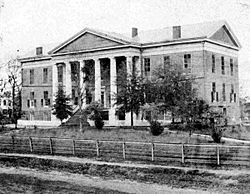
On March 3, 1845, Florida became the 27th state of the United States of America. Its first governor was William Dunn Moseley.
Almost half the state's population were enslaved African Americans working on large cotton and sugar plantations, between the Apalachicola and Suwannee rivers in the north central part of the state. Like the people who owned them, many slaves had come from the coastal areas of Georgia and the Carolinas. They were part of the Gullah-Gee Chee culture of the Lowcountry. Others were enslaved African Americans from the Upper South who had been sold to traders taking slaves to the Deep South.
In the 1850s, with the potential transfer of ownership of federal land to the state, including Seminole land, the federal government decided to convince the remaining Seminoles to emigrate. The Army reactivated Fort Harvie and renamed it to Fort Myers. Increased Army patrols led to hostilities, and eventually a Seminole attack on Fort Myers which killed two United States soldiers. The Third Seminole War lasted from 1855 to 1858 which ended with most of the remaining Seminoles, mostly women and children moving to Indian Territory. In 1859, another 75 Seminoles surrendered and were sent to the West, but a small numbered continued to live in the Everglades.
On the eve of the Civil War, Florida had the smallest population of the Southern states. It was invested in plantation agriculture. By 1860, Florida had 140,424 people, of whom 44% were enslaved and fewer than 1,000 free people of color.
Civil War, Reconstruction, and Jim Crow
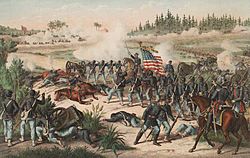
Following Abraham Lincoln's election in 1860, Florida joined other Southern states in seceding from the Union. Secession took place January 10, 1861, and, after less than a month as an independent republic, Florida became one of the founding members of the Confederate States of America. As Florida was an important supply route for the Confederate Army, Union forces operated a blockade around the entire state. Union troops occupied major ports such as Cedar Key, Jacksonville, Key West, and Pensacola. Though numerous skirmishes occurred in Florida, including the Battle of Natural Bridge, the Battle of Marianna and the Battle of Gainesville, the only major battle was the Battle of Olustee near Lake City.
A state convention was held in 1865 to rewrite the constitution. After meeting the requirements of Reconstruction, including ratifying amendments to the US Constitution, Florida was readmitted to the United States on June 25, 1868. This did not end the struggle for political power among groups in the state. Southern whites objected to freedmen's political participation and complained of illiterate representatives to the state legislature. But of the six members who could not read or write during the seven years of Republican rule, four were white.
After Reconstruction, conservative white Democrats strove for political power until they regained it in 1877. This was accomplished partly through violent actions by white paramilitary groups targeting freedmen and their allies to discourage them from voting. From 1885 to 1889, after regaining power, the white-dominated state legislature passed statutes to reduce voting by blacks and poor whites, which had threatened white Democratic power with a populist coalition. As these groups were stripped from voter rolls, white Democrats established power in a one-party state, as happened across the South.
The Great Freeze of 1894-5 ruined citrus crops which had a detrimental ripple effect on the economy of Central Florida, in particular.
By 1900 the state's African Americans numbered more than 200,000; 44 percent of the total population. This was the same proportion as before the Civil War, and they were effectively disfranchised. Not being able to vote meant they could not sit on juries, and were not elected to local, state or federal offices. They were not recruited for law enforcement or other government positions. White Democrats proceeded to pass Jim Crow legislation establishing racial segregation in public facilities and transportation. Without political representation, African Americans were shortchanged in the state. For more than six decades, white Democrats controlled virtually all the state's seats in Congress, which were apportioned based on the total population of the state rather than only on those able to vote.
Since 1900
In 1900, Florida was largely agricultural and frontier; most Floridians lived within 50 miles of the Georgia border. The population grew from 529,000 in 1900 to 18.3 million in 2009. The population explosion began with the great land boom of the 1920s as Florida went from an undiscovered frontier to a southern land speculator's paradise. People from throughout the Southeast migrated to Florida during this time, creating a larger southern culture in the central part of the state, and expanding on the existing one in the northern region. Along with this, many developers invested in land in the southern part of the State in areas such as Miami, and Palm Beach attracting more people in the Sothern States. When the Crash came in 1929, prices of houses plunged, but the sunshine remained. Hurt badly by the Great Depression and the land bust, Florida, along with many other States, kept afloat with federal relief money under the Roosevelt Administration.
Florida's economy did not fully recover until the buildup for World War II. The climate, tempered by the growing availability of air conditioning, and low cost of living made the state a haven. In 1945, at the closing of the War, many people from the Northeast and the Rust Belt migrated to the Central and Southern parts of Florida. Since 1945, migration from the Northeast and the Midwest has made non-native Floridians about 63% of the current population. In recent decades, more migrants have come for the jobs in a developing economy.
Boom of 1920s
1920s were a prosperous time for much of the nation, including Florida. Florida's new railroads opened up large areas to development, spurring the Florida land boom of the 1920s. Investors of all kinds, many from outside Florida, raced to buy and sell rapidly appreciating land in newly platted communities such as Miami and Palm Beach. Led by entrepreneurs Carl Fisher and George Merrick, Miami was transformed by land speculation and ambitious building projects into an emerging metropolis. A growing awareness in the areas surrounding Florida, along with the Northeast about the attractive south Florida winter climate, along with local promotion of speculative investing, spurred the boom.
A majority of the people who bought land in Florida were able to do so without stepping foot in the state, by hiring intermediaries. By 1924, the main issues in state elections were how to attract more industry and the need to build and maintain good roads for tourists. During the time frame, the population grew from less than one million in 1920, to 1,263,540 in 1925.
By 1925, the market ran out of buyers to pay the high prices, and soon the boom became a bust. The 1926 Miami Hurricane, which nearly destroyed the city further depressed the real estate market. In 1928 another hurricane struck Southern Florida. The 1928 Okeechobee hurricane made landfall near Palm Beach, severely damaging the local infrastructure. In townships near Lake Okeechobee, the storm breached a dike separating the water from land, creating a storm surge that killed over 2,000 people and destroying the towns of Belle Glade and Pahokee.
Great Depression
The Great Depression occurred in 1929. By that time, the economy had already declined in much of Florida from the collapse three years earlier of the land boom. The New Deal (1933–40) changed and reaffirmed the physical and environmental landscape of south Florida. Sewers, roads and schools were built by the Works Progress Administration (WPA). There were work camps for the young men of the Civilian Conservation Corps (CCC).
From 1930 to 1935, college students selected Fort Lauderdale, Daytona Beach and Panama City Beach as great places to take a spring break and party. The 1960s film Where the Boys Are increased attendance in Fort Lauderdale to 50,000. When this figure increased to 250,000 in 1985, the city began to pass laws restricting student activities. As a result, students moved to Daytona Beach from 1980-1990s. The figure for Fort Lauderdale dropped to 20,000; 350,000 visited Daytona Beach.
Florida legalized gambling in 1931 allowing a Parimutuel betting establishment. By 2014, there were 30 such establishments, generating $200 million in state taxes and fees.
Anticipating war, the Army and Navy decided to use the state as a primary training area. The Navy chose the coastal areas, the Army, the inland areas.
In 1940, the population was about 1.5 million. Average annual income was $308 ($6,433.62 in 2025 dollars).
World War II and the development of the space industry
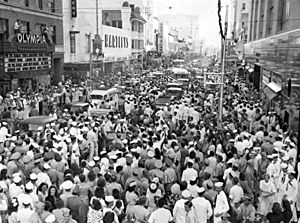
In the years leading up to World War II, 100 ships were sunk off the coast of Florida. More ships sunk after the country entered the war.
The state became a major hub for the United States Armed Forces. Naval Air Station Pensacola was originally established as a naval station in 1826 and became the first American naval aviation facility in 1917. The entire nation mobilized for World War II and many bases were established in Florida, including Naval Air Station Jacksonville, Naval Station Mayport, Naval Air Station Cecil Field, Naval Air Station Whiting Field and Homestead Air Force Base.
Eglin Air Force Base and MacDill Air Force Base (now the home of U.S. Central Command) were also developed during this time. During the Cold War, Florida's coastal access and proximity to Cuba encouraged the development of these and other military facilities. Since the end of the Cold War, the military has closed some facilities, including major bases at Homestead and Cecil Field, but its presence is still significant in the economy.
Due to the low latitude of the state, it was chosen in 1949 as a test site for the country's nascent missile program. Patrick Air Force Base and the Cape Canaveral launch site began to take shape as the 1950s progressed. By the early 1960s, the Space Race was in full swing. As programs were expanded and employees joined, the space program generated a huge boom in the communities around Cape Canaveral. This area is now collectively known as the Space Coast and features the Kennedy Space Center. It is also a major center of the aerospace industry. To date, all manned orbital spaceflights launched by the United States, including the only men to visit the Moon, have been launched from Kennedy Space Center.
Migrations and the civil rights movement
Florida's population mix has changed. After World War II, Florida was transformed as air conditioning and the Interstate highway system encouraged emigration from the north. Prior to development, Florida salt marshes were capable of producing large numbers of mosquitoes. The salt marsh mosquito does not lay its eggs in standing water, preferring moist sand or mud instead. Biologists learned to control them by "source reduction," the process of removing the moist sand needed by the mosquitoes to breed. To achieve this goal, large sections of coastal marshes were either ditched or diked to remove the moist sand that the mosquitoes required to lay eggs on. Together with chemical controls it yielded a qualified success.
In 1950, Florida was ranked twentieth among the states in population; 50 years later it was ranked fourth. Due to low tax rates and warm climate, Florida became the destination for many retirees from the Northeast, Midwest and Canada.
The Cuban Revolution of 1959 led to a large wave of Cuban immigration into South Florida, which transformed Miami into a major center of commerce, finance and transportation for all of Latin America. Emigration from Haiti, other Caribbean states, and Central and South America continues to the present day.
Like other states in the South, Florida had many African American leaders who were active in the civil rights movement. In the 1940s and '50s, a new generation started working on issues. Harry Moore built the National Association for the Advancement of Colored People (NAACP) in Florida, rapidly increasing its membership to 10,000. Because Florida's voter laws were not as restrictive as those of Georgia and Alabama, he also had some success in registering black voters. In the 1940s he increased voter registration among blacks from 5 to 31% of those age-eligible.
The state had white groups who resisted change to the point of attacking and killing blacks. Numerous bombings were directed against African Americans in 1951–1952 in Florida.
The state's population had changed markedly by immigration of new groups, as well as emigration of African Americans, 40,000 of whom moved north in earlier decades of the 20th century during the Great Migration. By 1960 African Americans in Florida had grown to 880,186 citizens. This represented 18% of the state's population. This was a much smaller proportion than in 1900, when according to the census, they comprised 44% of the state's population but numbered 231,209 persons.
Everglades, hurricanes, drilling and the environment
Long-term scientific attention has focused on the fragility of the Everglades. In 2000 Congress authorized the Comprehensive Everglades Restoration Plan (CERP) at $8 billion. The goals are to restore the health of the Everglades ecosystem and maximize the value to people of its land, water, and soil.,
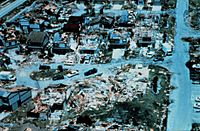
Hurricane Andrew in August 1992 struck Homestead, just south of Miami as a Category 5 hurricane, leaving forty people dead, 100,000 homes damaged or destroyed, more than a million people left without electricity, and damages of $20–30 billion. Much of South Florida's sensitive vegetation was severely damaged. The region had not seen a storm of such power in decades. Besides heavy property damage, the hurricane nearly destroyed the region's insurance industry.
The western panhandle was damaged heavily in 1995, with storms Allison, Erin, and Opal hitting the area within the span of a few months. The storms increased in strength as the season went on, culminating with Opal's landfall as a Category 3 in October.
Florida suffered heavily during the 2004 Atlantic hurricane season, when four major storms struck the state. Hurricane Charley made landfall in the Charlotte County area and cut northward through the peninsula, Hurricane Frances struck the Atlantic coast and drenched most of central Florida with heavy rains, Hurricane Ivan caused heavy damage in the western Panhandle, and Hurricane Jeanne caused damage to the same area as Frances, including compounded beach erosion. Damage from all four storms was estimated to be at least $22 billion, with some estimates going as high as $40 billion. In 2005, South Florida was struck, by Hurricanes Katrina and Wilma. The panhandle was struck by Hurricane Dennis.
Florida has historically been at risk from hurricanes and tropical storms. These have presented higher risks and property damage as the concentration of population and development has increased along Florida's coastal areas. Not only are more people and property at risk, but development has overtaken the natural system of wetlands and waterways, which used to absorb some of the storms' energy.
Environmental issues include preservation and restoration of the Everglades, which has moved slowly. There has been pressure by industry groups to drill for oil in the eastern Gulf of Mexico but so far, large-scale drilling off the coasts of Florida has been prevented. The federal government declared the state an agricultural disaster area because of 13 straight days of freezing weather during the growing season in January, 2010.
Fishing
In 2009-2010, "there were hardly any fish off Florida...they are finding fish all over Florida" in 2016. The federal government believes this is due to federal restraints on fishing.
Tourism
During the late 19th century, Florida became a popular tourist destination as Henry Flagler's railroads expanded into the area. In 1891, railroad magnate Henry Plant built at Tampa the luxurious Tampa Bay Hotel, which later became the campus for the University of Tampa. Flagler built the Florida East Coast Railway from Jacksonville to Key West. Along the route he provided for his passengers grand accommodations, including The Ponce de León Hotel in St. Augustine, The Ormond Hotel in Ormond Beach, The Royal Poinciana Hotel and The Breakers Hotel in Palm Beach, and The Royal Palm Hotel in Miami.
In February 1888, Florida had a special tourist: President Grover Cleveland, the first lady and his party visited Florida for a couple of days. He visited the Subtropical Exposition in Jacksonville where he made a speech supporting tourism to the state; then, he took a train to St. Augustine, meeting Henry Flagler; and then a train to Titusville, where he boarded a steamboat and visited Rockledge. On his return trip, he visited Sanford and Winter Park.
Flagler's railroad connected cities on the east coast of Florida. This created more urbanization along that corridor. This was followed, in turn by Turnpikes I-95 in east Florida, I-75 in west Florida. These routes aided tourism and urbanization. Northerners from the East Coast used I-95 and tended to settle along that route. People from the MidWest tended to use I-75, and settled on the west coast of Florida.
Theme parks
Florida's first theme parks emerged in the 1930s and included Cypress Gardens (1936) near Winter Haven and Marineland (1938) near St. Augustine.
Disney World
Disney selected Orlando over several other sites for an updated version of their Disneyland Park in California. In 1971, the Magic Kingdom, the first component of the resort, opened and became Florida's best known attraction, attended by tens of millions of visitors a year, spinning off other attractions and large tracts of housing.
The Orlando area became an international resort and convention destination with a wide variety of themed parks. The Orlando area features theme parks including Universal Orlando Resort, SeaWorld, and Wet 'n Wild.
Images for kids
See also
 In Spanish: Historia de Florida para niños
In Spanish: Historia de Florida para niños


